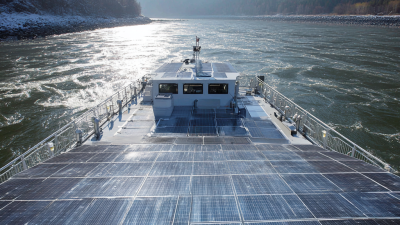Blog
- Home
- Blog
Transform Your Home with Clean Energy: The Ultimate Guide to Solar Panel Benefits and Installation
As the world increasingly turns towards sustainable practices to combat climate change, Clean Energy Solar Panels have emerged as a leading solution for homeowners seeking to reduce their carbon footprint and energy costs. According to the Solar Energy Industries Association (SEIA), solar capacity in the U.S. reached over 100 gigawatts in 2022, enough to power 18 million homes. Furthermore, the International Energy Agency (IEA) predicts that by 2025, solar energy will become the dominant source of electricity globally, highlighting its pivotal role in our energy transition.

This ultimate guide aims to explore the myriad benefits of solar panel installations, from financial savings to environmental impact, providing a comprehensive resource for those looking to enhance their homes while contributing to a cleaner planet. Whether you're motivated by savings on your utility bills or a commitment to sustainability, understanding the steps to effectively transform your home with Clean Energy Solar Panels is crucial in making an informed decision.
Understanding the Environmental Impact of Solar Energy on Your Home
Harnessing solar energy not only transforms your home but also significantly reduces its environmental footprint. By utilizing solar panels, homes can produce clean, renewable energy, which decreases reliance on fossil fuels. This shift is crucial in mitigating greenhouse gas emissions, as traditional energy sources are a leading contributor to climate change. Each solar panel installed contributes to a reduction in harmful emissions, making solar energy a sustainable choice for environmentally conscious homeowners.
Moreover, the installation of solar panels promotes
energy independence. With the increasing unpredictability of energy prices and supply, relying on solar energy allows homeowners to secure a more stable and affordable energy future. Additionally, the environmental benefits extend beyond just carbon emissions; solar energy systems can lead to less water pollution and habitat destruction associated with fossil fuel extraction and use. By transforming your home into a solar-powered sanctuary, you are playing an active role in promoting a healthier planet for future generations.
Exploring the Financial Benefits of Installing Solar Panels
The financial benefits of installing solar panels extend beyond saving on electricity bills. Homeowners can unlock several incentives and rebates that significantly reduce the initial investment in solar technology. For instance, tax credits and grants can cover a substantial portion of installation costs, encouraging more households to switch to renewable energy. Moreover, as traditional energy sources become more expensive, the long-term savings associated with solar energy will continue to grow, making it a financially savvy choice for homeowners.
However, recent reports highlight potential pitfalls in the solar installation market, such as misleading solar leasing agreements. In some cases, individuals unknowingly sign contracts that lead to unexpected financial liabilities, like substantial loans tied to their property. This situation can lead to confusion and distress, especially for those who believed they were benefiting from clean energy solutions. As the push for solar energy continues to gain momentum, it is crucial for homeowners to conduct thorough research and understand the terms of any agreements before committing to solar panel installations.
Transform Your Home with Clean Energy: The Ultimate Guide to Solar Panel Benefits and Installation
| Benefit | Description | Estimated Savings Over 20 Years | Environmental Impact |
|---|---|---|---|
| Lower Electric Bills | Solar panels convert sunlight into electricity, reducing your reliance on grid power. | $20,000 - $30,000 | Reduces CO2 emissions by approximately 20 tons over 20 years. |
| Increase Property Value | Homes with solar panels sell for more than those without, adding value to your property. | $15,000 - $25,000 | Encourages sustainable home ownership. |
| Tax Incentives | Federal and state tax credits can offset the installation cost of solar panels. | Varies, potentially $10,000 or more. | Encourages the shift towards renewable energy sources. |
| Energy Independence | Reduce dependence on fossil fuels and foreign energy sources. | Not directly quantifiable, but significant. | Decreases carbon footprints and promotes local energy use. |
| Low Maintenance Costs | Solar panels require minimal maintenance and have long lifespans. | Maintenance costs average around $300-$600 over 20 years. | Lower waste generation through reduced energy reliance. |
Key Factors to Consider When Choosing Solar Panel Systems
When considering solar panel systems for your home, several key factors can influence your decision. First and foremost is the type of solar technology to choose from, primarily monocrystalline, polycrystalline, or thin-film panels. Monocrystalline panels are known for their efficiency and longevity, making them suitable for homes with limited roof space. Conversely, polycrystalline panels, while slightly less efficient, offer a more budget-friendly option and can be a viable choice for larger rooftops.

Another critical aspect is the installation process itself. Assessing whether to hire a professional or opting for a DIY setup can greatly affect both cost and efficiency. Professional installation typically ensures optimal placement and integration with your home’s electrical system, thus maximizing energy production. Moreover, understanding local regulations, permits, and potential incentives is vital when selecting solar panel systems, as they can significantly affect installation time and overall financial benefits. By carefully evaluating these factors, homeowners can make an informed decision that aligns with their energy needs and financial goals.
A Step-by-Step Guide to the Solar Panel Installation Process
Installing solar panels can significantly enhance your home's energy efficiency and lower utility costs. The installation process begins with an assessment of your property to determine its solar potential. This includes evaluating roof orientation, shade from trees or buildings, and assessing the structural integrity of your roof to support the panels. Engaging a professional installer during this stage can provide insights into the best system design tailored to your specific needs.
Once the assessment is complete, the next step involves obtaining the necessary permits and approvals. Local regulations may dictate specific requirements for solar panel installations, so it’s essential to work with your installer to ensure compliance. Following this, the installation day involves mounting the panels onto your roof, connecting them to an inverter, and setting up the necessary wiring and electrical systems. After the panels are installed, a final inspection is typically required to ensure everything meets safety and operational standards, allowing you to enjoy the benefits of clean, renewable energy in your home.
Maximizing Your Savings: Tips for Efficient Solar Energy Usage
Maximizing savings with solar energy requires a strategic approach to installation and usage. According to the U.S. Department of Energy, households can save between $10,000 to $30,000 over 20 years by adopting solar power, especially when they leverage incentives like the Federal Investment Tax Credit (ITC), which allows homeowners to deduct a significant percentage of their solar installation costs from their federal taxes. To ensure optimal energy production, it’s essential to conduct a comprehensive analysis of your home’s energy needs and the solar system’s capacity.

Efficient solar energy usage also involves implementing energy-saving practices. According to the National Renewable Energy Laboratory, using energy-efficient appliances can enhance the effectiveness of your solar system. For instance, switching to LED lighting or Energy Star-rated devices can reduce energy consumption significantly. In addition, monitoring your energy usage patterns can help identify peak consumption times, allowing homeowners to strategize their energy usage to maximize savings.
By combining smart installation choices with these efficient usage tips, homeowners can fully realize the financial and environmental benefits of solar energy.
Related Posts
-

7 Ultimate Benefits of Choosing Power Solar Energy for Your Global Supply Needs
-

Navigating Challenges with Best Green Energy Solar Solutions
-

How to Successfully Navigate the Solar Panel Installation Process for Your Home
-

How to Leverage Renewable Solar Solutions for Global Market Growth
-

5 Best Power Solar Solutions Revolutionizing Renewable Energy Efficiency in 2023
-

Exploring Diverse Alternatives to Power Solar Panels for Sustainable Energy Solutions